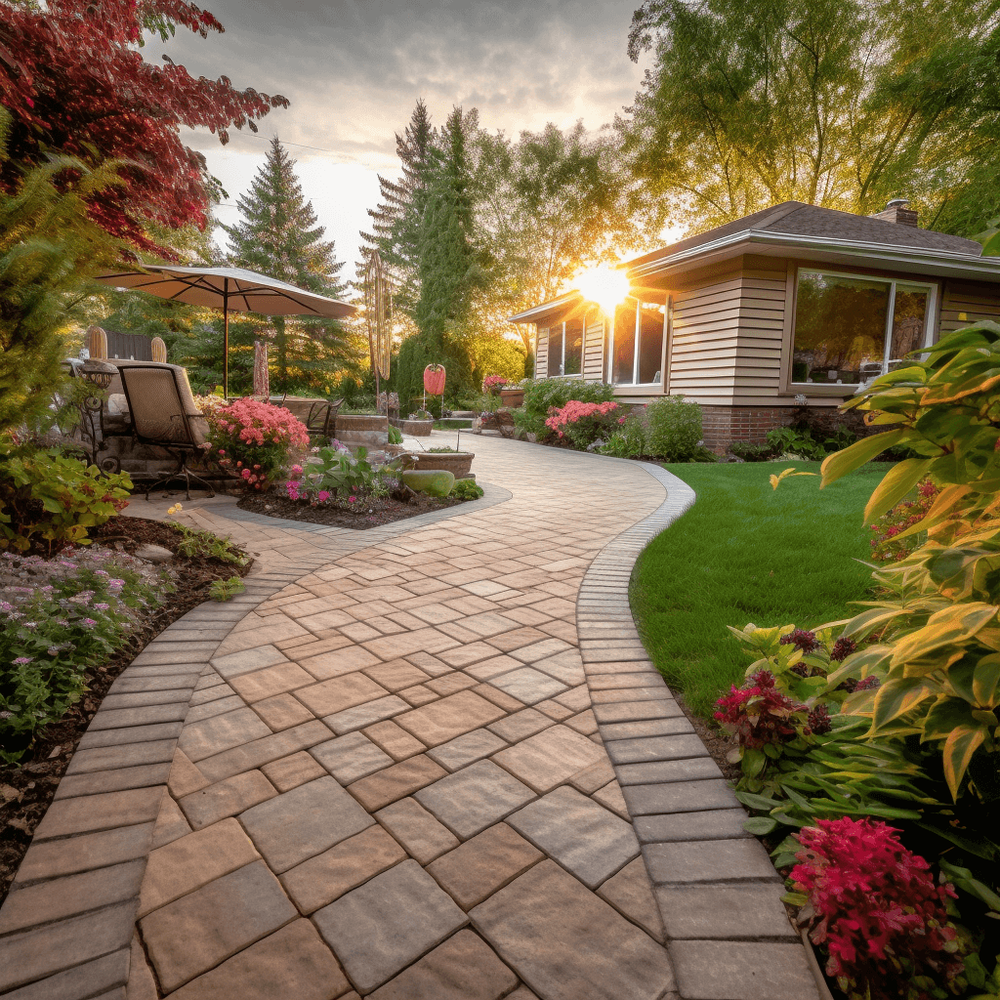
Transform your Arizona home’s grassy backyard into a striking outdoor paradise with our easy-to-follow, step-by-step guide on laying pavers on grass. This blog will teach you the ins and outs of creating an enchanting walkway that not only enhances the curb appeal but also provides safety and functionality to your landscape.
n
Follow along as we reveal expert tips, tricks, and techniques guaranteed to make this DIY project a breeze.
Key Takeaways
- n
- Choosing the best location, size, and shape for your paver walkway is crucial to maximize functionality and enhance curb appeal.
- Preparing a solid foundation with landscape fabric and sand base ensures proper drainage, stability, and longevity.
- Securing pavers with durable edging materials prevent shifting or sinking over time while filling gaps with sand enhances traction and prevents weed growth.
n
n
n
Planning Your Pathway
Choose a location for your walkway, decide on the shape and size of your pavers, and gather all the necessary tools and materials.
Choosing The Best Location
Selecting the ideal location for your outdoor walkway is essential to maximize its functionality and enhance the appeal of your Arizona home’s landscaping. Begin by assessing the natural flow of foot traffic in your yard to identify areas where a walkway would be most beneficial.
n
For example, consider connecting frequently used spaces such as the patio, pool, or garden.
n
In addition, keep an eye out for possible challenges like large roots from nearby trees or underground utilities that could complicate construction.
Deciding On The Shape And Size
Once you’ve chosen the location for your outdoor walkway, it’s time to think about the shape and size of your path. The design possibilities are endless! Consider a meandering or curved pathway to create visual interest in your yard.
n
Alternatively, a straight pathway leading directly from one point to another could be practical if you want an efficient route between different areas of your garden.
n
It’s also important to consider how wide you want your walkway to be and how much grass will remain on either side of it. A narrower path can look sleek, while a wider one can accommodate both foot traffic and small wheeled items like lawnmowers or wheelbarrows.
Gathering The Necessary Tools And Materials
Before starting your paver walkway project, it’s important to gather all the necessary tools and materials. For this project, you will need sand, string, landscape fabric, or black plastic sheeting, pavers of your choice including patio blocks or porcelain pavers, and a paver edging of some kind.
n
It’s crucial to ensure that these materials are high-quality and durable, as they will be exposed to outdoor elements year-round. One great way to get inspiration for different types of paving stones is by looking through home improvement magazines or online catalogs for ideas on what style and design may work best for your lawn.

Preparing The Foundation
Clear the area, removing any grass or other debris. Level the ground with a rake and check for low spots using a level tool.
Clearing The Area
The first step in laying your paver walkway on grass is clearing the ,dirt. Start by removing any rocks, debris, or other obstacles like ,slope surfaces that could interfere with the foundation of your walkway.
n
Ensure you remove all vegetation within the intended path as this will prevent weeds from growing between the pavers down the road.
n
Next, level out the ground underneath where you want to place your pavers. This ensures proper compaction of soil for stable placement when it’s time to install them properly later on.
Leveling The Ground
Before laying down the pavers, it’s essential to ensure that the ground is leveled. This step may seem tedious, but it will pay off in the long run and prevent unevenness or tripping hazards.
n
First, clear out any debris or grass from the designated area. Then use a shovel or rake to flatten out any hills or bumps in the soil.
n
Once you have a level surface, you’ll need to assess if there are any low spots that might collect water after rainfalls. If so, consider filling them in with additional soil or digging out some of the high points as needed before proceeding to lay your landscape fabric and base layers.
Laying Down Landscape Fabric
After leveling the ground, the next step is laying down landscape fabric to prevent weeds from growing in between your pavers and degrading their stability. Landscape fabric is a permeable material that allows water, but not weed seeds, to pass through.
n
It’s best to use black plastic sheeting or woven polypropylene fabric, cut into manageable sections according to the dimensions of your walkway.
n
Once you’ve laid out all your sections of landscape fabric, secure them in place with stakes or landscaping pins before adding the sand base on top. This will ensure that it stays put and doesn’t shift around during the installation process.

Laying The Pavers
Create a sand base by pouring sand over the landscape fabric, then lay the pavers in your desired pattern, ensuring that there is spacing between each one.
Creating A Sand Base
Before laying down the pavers, it’s essential to create a stable and level foundation. This requires creating a sand base that serves as a cushion between the soil and pavers.
n
Start by spreading an even layer of sand over the landscape fabric you previously laid out. A depth of about 1 inch is sufficient for most applications, but if your soil is particularly soft or prone to erosion, you may need to add more sand.
n
Rake the sand smooth and compact it using a hand tamper or plate compactor. This ensures that there are no air pockets or uneven areas in your base.
n
By taking this crucial step in creating a solid foundation for your walkway, you’ll be sure to enjoy years of problem-free use from your newly installed paver path! Remember, proper preparation pays off big-time when it comes to any landscaping project.
Laying The Pavers In The Desired Pattern
Once you have created a sand base, it’s time to lay down your pavers in the desired pattern. Whether you want a classic herringbone or intricate mosaic design, the possibilities are endless.
n
It’s important to keep spacing consistent between each paver and use string lines as markers to ensure straight lines.
n
If you’re feeling adventurous, experiment with different sizes or shapes of pavers for added visual interest. Consider incorporating contrasting colors or patterns that complement your home’s exterior design.
n
Don’t forget to use interlocking edges and secure your walkway with proper edging materials for longevity and stability.
Securing With Edging
One of the essential steps in laying pavers on grass is securing them with edging. Edging helps keep the walkway in place and prevents shifting or sinking over time. The type of edging you choose may depend on your budget, personal preference, or design style.
n
Plastic, metal, and concrete are some popular options for paver edging.
n
For example, plastic edgings are cost-effective and easy to install but might not be as sturdy as concrete or metal ones. Metal edgings are long-lasting but can rust over time if they’re not correctly maintained.
n
Concrete edgings provide a more natural look and blend well with the surroundings; however, they’re challenging to work with when forming curves or angles.
Finishing Touches
Fill in the gaps between the pavers with sand and use a compactor to smooth out the walkway.
Filling In The Gaps With Sand
Once you’ve laid down your pavers in the desired pattern, it’s time to fill in the gaps with sand. This will not only help keep the pavers securely in place but also prevent weed growth between them.
n
Next, use a broom to sweep the sand into all of those nooks and crannies until they are completely full. You’ll want to make sure that each gap is filled with enough sand so that it’s level with the top of each paver.
n
Once you’re done sweeping, use a hose to gently spray water over everything so that it settles into place and holds everything together tightly.
Compact And Water The Walkway
After laying your pavers on grass for a stunning outdoor walkway, it’s important to compact and water the area. This step ensures that everything is level and secure while also setting the sand base in place.
n
Start by using a compactor machine across the entire walkway, ensuring all gaps are filled with sand. Next, use a garden hose or watering can to thoroughly water the area, allowing the sand to settle into any empty spaces that may have formed.
n
Compacting and watering your walkway not only creates traction but makes maintenance easier since weeds won’t sprout up as easily through tightly packed soil.

Benefits Of Laying Pavers On Grass
Laying pavers on grass offers a multitude of benefits, from adding curb appeal to increasing safety and making maintenance easier.
Adds Curb Appeal And Beauty To Your Lawn
Laying pavers on grass adds instant curb appeal and beauty to your lawn. The clean lines of the walkway create a defined path that draws the eye and makes your outdoor space look more put together.
n
With so many different types of pavers available, you can customize the color, shape, and design to match your home’s style or add a pop of personality. Porcelain pavers offer a sleek modern look, while patio blocks give a rustic feel perfect for Southwest-inspired landscapes.
n
Not only does it look great, but laying pavers on grass also has practical benefits too! It provides better traction underfoot than slippery grass when wet or icy in colder months.
n
Plus, once installed, maintenance is incredibly simple – just sweep sand into the gaps between stones as needed to prevent weeds from growing through.
Increases Safety And Traction
Laying pavers on grass not only adds beauty to your lawn but also increases safety and traction. Unlike a plain grass path, paver walkways provide better traction and slip resistance, preventing accidents due to wet or uneven surfaces.
n
Pavers also create a sturdy surface for walking or driving on that won’t sink into the ground like grass would when it gets muddy or saturated with water. This makes it easier and safer for you and your visitors to navigate around your property without getting injured.
Makes Maintenance Easier And More Efficient
After you’ve finished laying your pavers on grass, maintenance becomes a breeze. Since the pathway is now raised from the surrounding lawn, it’s easier to mow and trim around it without any fear of accidentally damaging the pavers.
n
You won’t have to worry about weeds growing between them either since they’re secured with edging and filled with sand.
n
Not only that, but these beautiful pathways require very little upkeep once installed properly. They can withstand heavy foot traffic (and even vehicular traffic in some cases) without losing their aesthetic appeal or functionality.
Tips For A Successful Project
To ensure success, it’s important to choose durable and high-quality pavers, use the right tools and techniques, and perform regular maintenance. Follow these tips for a stunning outdoor walkway that will last for years to come.
Choosing Durable And High-Quality Pavers
When it comes to choosing pavers for your outdoor walkway, it’s essential to select durable, high-quality materials that will withstand Arizona’s harsh weather conditions.
n
Porcelain pavers are an excellent option for their durability and resistance to the elements. They come in various styles, colors, and sizes that can match any design aesthetic you may have in mind.
n
,Patio blocks also provide a beautiful option that is easy to install and maintain.
n
Using cheap materials may save you money upfront, but they’ll end up costing more in the long run due to constant maintenance or replacement expenses. A reputable landscaping company can help assist with selecting durable pavers that meet your budget and preferences while still providing a stunning outcome.
Using The Right Tools And Techniques
To ensure a successful paver walkway installation, it’s crucial to use the right tools and techniques. Firstly, make sure you have all the necessary equipment for the job, which includes a shovel, rake, wheelbarrow, level, trowel, and rubber mallet.
n
Additionally, it’s essential to know how to properly lay down landscape fabric and compact soil before adding sand and pavers. Be sure to follow each step carefully as this will prevent weeds from growing in between your newly installed pavers while providing proper drainage for water runoff during heavy rainfalls.
Regular Maintenance To Keep It Looking Great
Regular maintenance is essential to ensure that your grass and paver walkway remain in top condition. For instance, you’ll need to clean the surface of your walkway regularly by sweeping away debris, leaves, and branches that may accumulate on it over time.
n
Minor repairs will likely be needed from time to time, such as replacing damaged pavers or edging stones and refilling gaps with sand.
n
Lastly, make sure not to neglect to trim the edges where they meet the grass.
Conclusion
Congratulations! You are now armed with a step-by-step guide on how to lay pavers on grass for a stunning outdoor walkway. With the right tools, materials, and techniques, creating a beautiful pathway can be an easily achievable DIY project that enhances your lawn’s curb appeal while offering safety and efficiency benefits.
n
Remember to choose high-quality pavers and maintain them regularly to keep your walkway looking great for years to come.
nn

